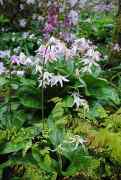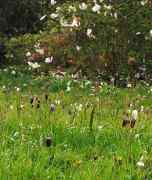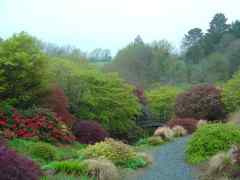


In April David and Judy led a group of intrepid members and friends on a tour of some of the gardens in south Cornwall. You will read from the accounts of the trip that Cornwall had nothing of the Riviera about it, but people and plants braved the elements in true Hardy style. Our thanks to Becky, Hilary, Traude, Leila and David for providing the photos.
I first visited The Garden House about 20 years ago, have since recommended it to friends and family, or dragged them there, over the years and have never been disappointed! I rate it as one of the finest gardens in the land!
Having heard that things had changed somewhat since Keith and Ross Wiley left, I wondered if there might be some disappointments, but apart from the weather (wet and misty) and the slow appearance of much spring colour and texture, following a harsh winter and slow spring, the garden was as delightful and interesting as ever.
I particularly enjoyed the swathe of red and purple tulips in the old walled garden which is situated amongst the terraces surrounding the tower; all that remains of a 16th century house. Also the Wild Flower Meadow, near to the Acer Glade, with spring flowering bulbs including an impressive display of snakeshead fritillary. Equally as impressive were the large groups of trilliums bordering the lawns near the imposing Georgian mansion. Originally the vicarage for Buckland Monachorum, it is now the restaurant serving good, home made food. Also bringing colour and grandeur were the acers, camellias, azaleas and the wedding cake trees, which are quite a feature of the central part of the garden. The views over the garden and valley towards the church and the edge of Dartmoor are spectacular, particularly on a clearer day than ours!
In a short article I can’t begin to do justice to the legacy that is The Garden House. Founded by Lionel and Katherine Fortescue in the 1940's, enlarged with great vision, artistry and research (not to mention hard work) by Keith Wiley, head gardener from 1978 until 2003, with Matt Bishop now as the Head Gardener, this garden has evolved into a series of different gardens which seamlessly merge and blend into the surrounding Devon landscape. There is just such an enormous variety of planting and of gardening styles, something to suit all tastes and interests, in a wonderful setting with a wonderful atmosphere.
But my lasting impression, from my visits over the years, is the vibrant swathes of bulbs, annuals, perennials (notably the grasses), trees and shrubs, many rare introductions and familiar plants that have been put together to create what Keith Wiley describes as “New Naturalism", his contribution to gardening today.
A gem of a garden not to pass by when travelling south west!
What is it that brings joy to the hearts of Hardy Planters and evinces a groan from our long suffering coach driver? Yes - a well stocked nursery with plenty of plants to buy. Day 2 found us at our first stop at Trevena Cross Nurseries which specialises in southern hemisphere plants especially proteas and their relations. Driving into the car park we could see what the harshest winter for many years had done to the cordylines and other palms planted there - they were dead. After a short talk by the manager we were let loose and were pleased to find, not just exotic plants, but plenty of others to exclaim over. In the far corner we soon found the ‘Bargain Basement’ and enjoyed hunting out choice specimens at low prices. In my case I bought two corokias - 'Bronze King' and 'Sunsplash' - for £3.50 in total. I shan’t feel too upset if either succumbs next winter at that price. Both were good sized plants as well. Well worth a visit if you are ever in the vicinity.
Through Trevena and Caerhays and Mawes
Our coach kept rolling - no pause
Our Graham the fearless
In skill he is peerless
And all for the Hardy Plant cause.
This was my third visit to Trevarno gardens and grounds but it was just a taster for most of the group. It really does have something for all the family; for those holidaying in the area it has appeal for all ages. It is also free on production of an RHS membership card for the cardholder, which is a big saving.
The grounds were at their best as it was spring, so we set out on the Estate Walk admiring the bluebells and the fresh green of the newly- emerging leaves on the trees. This walk culminated in a visit to the National Daffodil Collection where you could mark down the daffodils you wanted to buy on an order form as you saw them growing in alphabetical order. Much easier was to see some chosen blooms displayed in the restaurant and choose from those.
The lake with the beautiful boathouse was my favourite place. There are ducks and geese on the lake along with Rex, the black-necked swan; he is lonely, awaiting a new mate. His wife was taken recently by a fox.
Child that I am, I loved Santa’s reindeer - on holiday there at Trevarno. Several of the girls were expecting; it would have been lovely to see calves but it wasn’t to be.
I met a Hardy Plant member at Malvern who was going there just to see the Steam Railway Restoration Project and who wanted to know if his wife would enjoy the gardens……Well, in the summer the herbaceous borders around the Great Lawn are stunning. There are many peafowl strutting around, also guinea fowl and golden pheasants, all rather noisy. The restaurant is excellent, especially the cakes: you can pick up a receipt sheet for a very small sum.
There are workshops producing organic handmade soap and skin care products around the Courtyard. Buying slightly damaged soap there is a good option if it is for personal use and of course it is sold nicely packaged in the gift shop.
There is the amazing Gardening Museum too, which is an absolute must where you can see all the tools that were in our Grandads' sheds and also in our fathers' for some of us. The seed packets I remember from my childhood with their pretty flowers on the outside: did they ever grow like this? There are fascinating glass cloches, grape ripeners and cucumber straighteners too. Lawn mowers through the ages and many other antique garden tools are there.
Our visit really was short but I hope some of us will be able to visit again. I can recommend Trevarno to everyone.
Having traversed the River Fal from Falmouth to St. Mawes on the ferry and climbed a rather steep hill, we arrived eventually, rather breathless, at Lamorran House on the Roseland peninsula.
The situation of the garden, being on a south-facing hillside, means that tropical and tender plants are the main feature. This was apparent as soon as we entered and were given a short talk by the gardener explaining that the garden had been planned in the Italianate style by the current owners, Mr. & Mrs. Dudley-Cooke, their influence having been gardens between Nice and Genoa.
We wandered along the steep winding paths which zig-zagged down the slope in such a way as to preclude views of much of the garden at any one time. Statues, streams, bridges, temples and a grotto gave an element of surprise round every corner and there was a viewing platform giving lovely views across the river. There were also some Japanese features including a koi pond.
The densely planted four acre garden included exotic plants such as palms and tree ferns, Dicksonias and Cyathea species. Rhododendrons and azaleas provided vibrant colour and we also saw agaves, aloes, puyas and aeoniums on the rocky slopes. More tender plants were growing in a walled garden by the house and here, in full flower, was a Clianthuspuniceus (Parrot’s bill) with its brilliant red flowers. There were also southern hemisphere plants such as proteas, callistemon and acacias.
After a refreshing cup of tea we descended steep paths back to St. Mawes where the coach was waiting. Although most of the plants grown in the garden were not those which would survive in my own, I found the garden intriguing and certainly worth a return visit in the future.
On Saturday May 1st we were warmly greeted by Tina Prichard - a lovely, smiling, cheerful northern lady, who explained to us how she and her partner were able to extend their rather narrow plot to an acre. Cleverly, the design makes the garden seem a lot larger by having an upper and a lower area. The upper is devoted to unusual shrubs, many set off well with deep red tulips. The lower area bordering the road was a series of rooms densely planted for all-round interest. Pulmonaria 'Roy Davidson' looked particularly good - a gorgeous sea-blue tinged plant. Pale lemon tulips also looked excellent amongst golden valerian and euphorbias. There was also an area of the species tulip, hageri. Tina even has a small water feature giving a gentle sound of running water together with beautiful birdsong - occasionally marred by the closeness of a busy road,
At the far end of the garden was a wonderful collection of poultry - White Crested, Black and Gold Laced Polands, Salmon Faverolles, Frizzled and Smooth Chamois Polands. I could have taken one home in my bag.
This was a garden which was happily in proportion, with no straight lines, giving a lovely flow and a feel of informality. There were plenty of seats to enjoy coffee - actually in the sunshine - and a good small nursery selling very healthy plants. It was a very personal garden with many unusual plants and obviously loved and cared for with an artistic eye. Thank you, David, for finding this treasure.
There was a young lady called Pippa
Who was reading a blue bodice-ripper
When challenged on this
She replied with a hiss
'What d'you expect from a Hardy Plant tripper?'
Caerhays Castle has a 100-acre woodland spring garden, open from February to May each year. It contains the National Collection of Magnolias, together with many stunning rhododendrons, azaleas and camellias. This is an historically important collection of mostly Chinese shrubs, many collected by the plant hunters Ernest Wilson and George Forrest.
Plant labels in the gardens give not just the name of the plant, but who collected it, where and when. This brought home how much is owed to these explorers and their generous patrons, in this case the owners of Caerhays Castle. Clearly marked routes go through the hilly gardens, and there are gorgeous views of the sea and nearby coves. The grassy slopes are thickly covered with primroses, violets and bluebells - a lovely peaceful contrast to the colourful shrubs around them.
Burncoose Nurseries is a mail order company run by the owner of the Caerhays estate, Charles Williams. His great grandfather bred the original x williamsii camellia at Caerhays, and Burncoose Nurseries continue the breeding program. Their yellow magnolia was on sale for £66, but I don’t think we brought any back with us!
Bosvigo was an afternoon visit to a two-acre garden on the outskirts of Truro. The owner, Mrs Parry, said she had been gardening here for the past 40 years and hoped we wouldn't be disappointed as she thought the garden looked its absolute best during the summer months.
Entering a woodland area to the side of the Georgian house I was amazed at the sight. Shady under tall mature trees, winding paths curved around large beds containing magnolias and acers. Soft pink tulips echoed the magnolia flowers; hostas emerging, erythroniums and epimediums by the hundred. Patches of ophiopogon gave a soft blue haze as it all mingled and blended together. An enchanting area with a lovely atmosphere.
Steep steps up the walls took us to paths alongside the hillside: bluebells up here and fritillarias. Masses of emerging agapanthus clumps gave a hint of the summer picture. No sign of the 'hot' colour theme for which this garden is famous, apart from a walled area where dark-leaved acers were underplanted with bright orange tulips.
A very tidy nursery area sold plants propagated from the garden, some unusual and reasonably priced. I think a lot of us succumbed again!
I was relishing returning to Plantworld after approximately seven years. I remember visiting on a beautiful warm sunny day and spending a long time looking around the garden, which is laid out to represent each of the five continents plus a cottage garden and a Mediterranean garden.
We arrived en route home from a wonderful few days visiting gardens in Devon and Cornwall but the weather was dreadful, cold, windy and raining. A glimpse of a substantial pile of plants on the compost heaps bore testament to the harsh winter suffered by the nursery.
The intention was for us to have lunch in the cafe at the nursery and we accordingly divided into two groups. Most of the group allocated first sitting were thankful to seek refuge from the atrocious weather in the restaurant. A few hardy souls ventured into the nursery and garden but didn't linger too long. Who could blame them?
I was in the group allocated second sitting but after a quick look at the nursery and garden the awful weather sent most of us scurrying back onto the coach. As I had been asked to write an article for the newsletter on our visit to the nursery I felt I could only do this if I made an attempt to view it properly. I set off alone wearing so many layers I looked like 'Michelin Woman' and I was still cold!
The layout of the garden was pretty much as I remembered but it had been ravaged by the harsh winter. Many surviving plants were still recovering and I noticed huge phormiums which were decimated. Mount Everest was appropriately bitterly cold but I felt warmed by a huge pieris which was 'glowing'.
I headed through the Himalayan Valley to Siberia which was surprisingly the warmest place. The garden was now being whipped by a gale and I was finding it hard to make notes as my fingers were too cold. I made my way back to the cafe in search of warmth and could see that the first sitting of diners were reluctant to leave, but we all eventually sat down to a warming lunch of hot soup and sandwiches which was most welcome.
The nursery has an excellent seed catalogue with a good reputation. The seeds are collected from the many and varied plants grown in their gardens so it will be interesting to see how their seed collecting will fare this year.
But it's not all doom and gloom. I read in the newspaper today that Ray Brown, who owns Plantworld, has managed to grow Meconopsis betonicifolia which are notoriously difficult in Devon as they require cool acidic conditions. He planted them in a shaded area 10 x 20 yds using recycled tomato bag compo, keeping them sheltered from the midday sun and the area damp. They were a huge success. Come to think of it the conditions on the day of our visit were ideal. No wonder he was so successful!.
As an enthusiastic viewer of Ruth Watson’s 'Country House Rescue', I was looking forward to meeting the Robbs and viewing the house and grounds. The one-and-a-half miles down a tortuous, very narrow lane took nerves of steel on the driver’s part and caused a number of cars to back up the road away from us.
This was the final visit on a busy and varied weekend, which had been very cold and wet at times.
The first view of Cothay Manor is magical. Built in 1485, the mellow stone of the Gatehouse is beautifully reflected in the mirrored pool outside the gateway. Mary Anne Robb introduced herself to the group as the head gardener: she was very enthusiastic about the garden which she said was a summer one, but there were lots of white lily tulips to see at present. She directed us to wander round anywhere. The garden is set round a 200-yard Yew Walk laid out in the 1920's by Col Reginald Cooper, an old friend of Harold Nicholson, of Sissinghurst. Off the Walk are many garden rooms all with individual character. Beyond the gardens the river Tone runs, a bubbling, meandering stretch of water that brings the grounds alive. There is a bridge to cross the water and the area is set out with blossom and estate trees. The river has carved a shallow valley, which allows for the bog garden. A place of giant stepping stones around which gunnera, irises, primuli and ferns were just starting to unfurl.
Heading back to the Gatehouse we meet Mr Robb with the Rough Haired Dachshund which growled at us. Abject apologies followed: his daughter’s dogs had no training and in his own words “That is no way to treat the punters – they do not like it”. We retreated to the Gatehouse where under a deep blue ceiling covered with gold stars we enjoyed a cream tea with the daughter’s other dogs, Pekineses, snuffling round the tables looking for treats.
I am not sure that Ruth’s advice has been heeded, but the garden and the family are a delight to meet and the house set in a time warp.